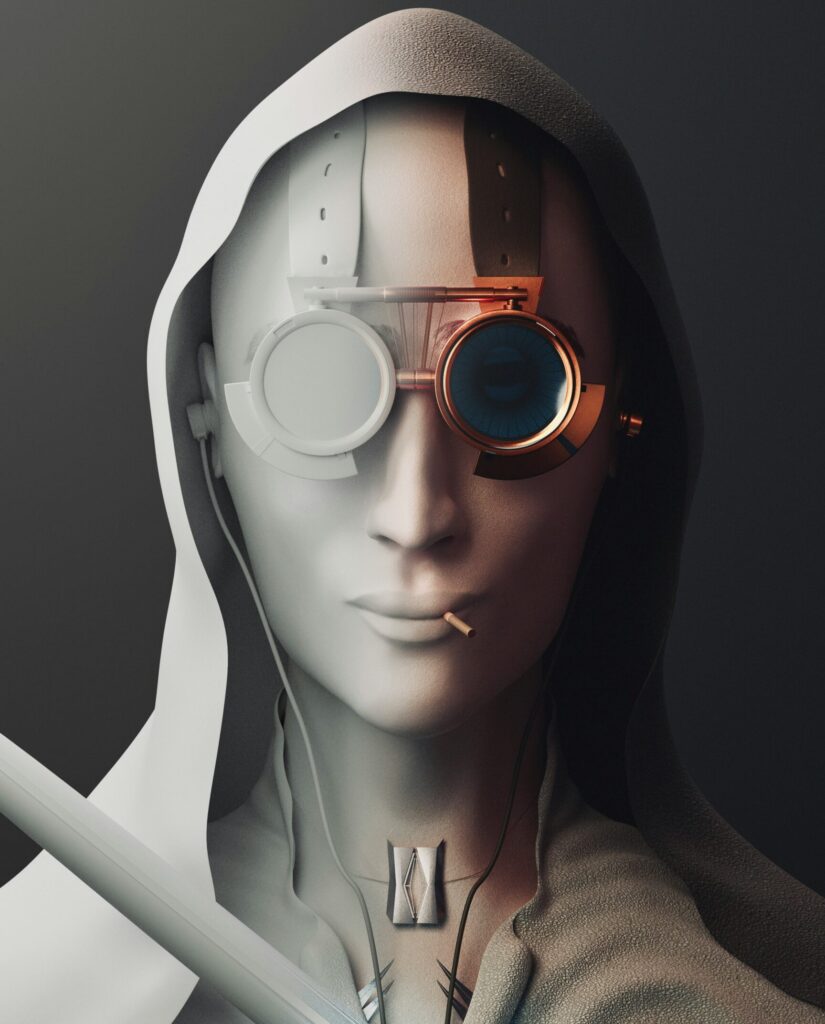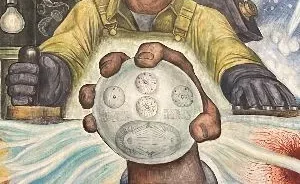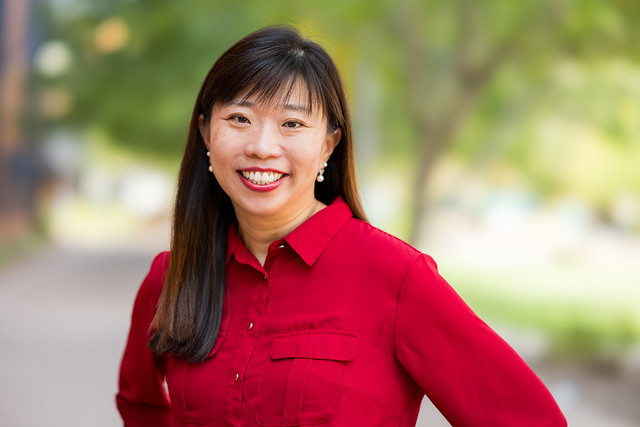A long time ago, on one auspicious day, a robot cardinal was elected to be pope.
“All factions now are agreed on itself has taken a hand in the deliberations. The computer has been strongly urging the candidacy of the robot. I suppose we should not be surprised by this loyalty among machines. Nor should we let it distress us…. “Every era gets the pope it deserves,” Bishop FitzPatrick observed somewhat gloomily today at breakfast. “The proper pope for our times is a robot, certainly.”
Is it? And is it a certainty, ever?
In 1971 Good News from the Vatican, from which the above was excerpted, was published to award-winning acclaim.[1] The unfolding drama of the robotic papal election is still fiction for now but narratives surrounding smart machines and AI (artificial intelligence) have endured. Today, our cultural fascination with machinic powers ranks high with interests in automation, widely understood as the machine-autonomous achievement of specific goals. Popular portrayals of AI also highlight new realities and anxieties whereby robots supplant human intelligence and work.

These machine-centered visions of AI futures raise critical questions about human agency [2] and the extent to which we are aligning AI development with our traditions, values and the highest good. In these ways, the remit set by the Social Science Research Council to address in this forum, the “Human Spirit and Agency in an Age of Digital Mediation and AI” is of profound and timely importance. Drawing upon my research on religious human-machine communication and culture, I will make the following contributions to broaden common ontological understandings of AI and agency in this essay.
First, I will discuss human-to-machine communication in AI development, with a focus on how AI systems rely on human communication, including authority practices enacted by religious elites and clergy. In turn, we need to remember entrenched powers and AI governance beyond the presentist focus on machine displacement and disruptions. Second, I will discuss how AI is constituted by human labor in its deployment, including the work of religious professionals and volunteers in staging public demonstrations. In this vein, we understand AI as a system of embodied labor and meaning-making with everyday communication and care. (Re)membering AI helps us attend to material conditions and intersectional inequalities of living communicators at work, even as we integrate AI into spiritual settings. Considering these two related points will underscore how agency is always more than an attribute of machines or humans. Agency is distributed and contextually accomplished in embedded religious AI automation.
Remembering Human Authority Amid the Automation Allure
Not a pope but multiple robotic priests have captured worldwide media attention recently. AI-scripted religious services held by avatars on screens have replaced human clergy in leading religious services, including the call to worship, hymns, pastoral prayers and sermon delivery. AI-powered religious chatbots now provide seekers with answers, read texts and recite prayers. Although not yet a widespread phenomenon, stories of AI automation point to new machinic agents at work, as well as changing realities of authority within the religious domain.[3]

Thus, it behooves us to consider key communicative processes between humans and AI at the origins and operations of generative AI. Although sometimes unseen and unrecognized, religious data work involves a panoply of human operators, including the input of clergy as domain experts. Processes of religious datafication are laden with historical and present power asymmetries as leaders ascribe meanings to data, curate and structure training data, and validate machine learning models.[4]
For instance, consider how the development of AskCathy.com and the Cathy (Churchy Answers That Help You) bot is infused with human leadership, expertise and power. The bot draws upon the latest version of ChatGPT but only after prioritizing official Episcopalian resources. According to Reverend Lorenzo Lebrija, Cathy’s co-principal developer, the “specific retrieval mechanism for Cathy tailored to the Episcopalian Church” helps to ensure that the Chatbot avoids hallucinations. Specifically, it is noteworthy that “[w]hen possible, Cathy cites her sources. Her library, prioritized over the rest of ChatGPT’s resources, includes over 1,000 pages from the Episcopal Church’s website, The Book of Common Prayer, and authorized publications from the Forward Movement, a ministry of the Episcopal Church.” [5]

Source
In addition, the developers of this chatbot have constructed Cathy with specific user scenarios in mind. Envisioned scenarios are incorporated into AI training to inform machine learning models, and in this case included, “a lay minister leading a parish who is looking for TEC-specific liturgies, a church member parsing through the denomination’s complex bylaws, a priest looking to accelerate their service planning to spend more time with parishioners or a person curious about the denomination’s positions on controversial topics.” [6]
In these ways—despite how self-acting this AI bot appears on the surface—one can observe the centrality of human leadership and communication practices in shaping the performativity of AI. AI automation relies on human input and resources, as evidenced also in the case of the world’s first “nano-chapel” opened in Poland, in October 2024. [7] Conceived by Priest Radek Rakowski, a special app was created in collaboration with a smart home systems company, to allow parishioners to unlock chapel doors outside of Mass and service hours, operate the lights and order a drink from the coffee machine. At the lectern, visitors can interact with a ChatGPT-powered AI guide to ask the AI to read Biblical passages, recite prayers, and answer questions relating to faith and theology. Reportedly, this system took a year of AI training (and customization using the Holy Bible, the Catechism, and the documents of the Church), with the involvement of Father Rakowski of the Roman Catholic parish of Lacina. [8]

These examples of religious human-machine communication show that we need to remember corporeality and continuities in governance, even as we relate to smart machines. As Luke Munn, in Automation is a myth explained, “[d]ata sets and programming are dense packages of human labor, collected over years and crystallized into digital forms.” [9]
(Re)membering Human Communication Amid Automation Performances
Furthermore, we need to consider how the work of deploying AI requires continued investment of human labor. Public demonstrations of religious AI are often designed to evince smooth operations of machine autonomy. Yet indispensable for the constitution of religious automation are localized enactments of human communication and care for the generation of religious experiences, instructions, and animated blessings. [10]
For example, what was apparent in my observations of the robot monk, Xian’er, is that its performance required the collaborative work of nuns and volunteers. Public staging of the robot required human efforts to set up its demonstrations, enact problem-solving, and vigilantly care for its day-to-day proper functioning by managing its logistics and battery operations.
In this case of religious human-machine and machine-human communication, temple workers assisted in rectifying instances of the robot’s discursive breakdowns. Conversational repair work involved multiple dimensions as one worker helped to rephrase some questions, by suggesting synonyms or simplifying my inquiries to the robot to elicit a response. Another temple assistant reacted to the narrative hiccups by bringing out a wireless microphone to amplify voice exchanges. Hence, considerable corporeal efforts were expended to render this robot operable and social, which included impromptu improvisation and communication practices to temper performance expectations.
Notably, part of the communication repair also consisted of the bot’s fallback response in instances where it could not comprehend. One robot monk’s standard default reply was to divert queries back to the lead priest (e.g. “I need to check with my Master (Shifu)”). Interestingly, this loop back to human leaders was also observed in exchanges with Cathy, where the chatbot “often responded to requests for advice in part by suggesting speaking with a trusted priest, spiritual advisor or professional counselor.”
Thus, counter to much-publicized fears of religious automation taking over clergy jobs, new modes of AI development can be robust and deferential to existing governance. Religious leaders, workers and volunteers act as regulators of AI, by steering human-machine communication to align with the ideals of the religious community. These examples illustrate “bounded religious automation” whereby emerging and so-called autonomous machines are influenced and constrained by socially and historically situated power and personalities. [11]

In this Era: Remembering and (Re)membering AI
Though we have yet to witness the appointment of robotic cardinals, recent innovations illustrate how bots can function as new religious communication agents. Yet despite what is generally understood as autonomous machinic accomplishments, AI performativity does not simply happen but is constructed portion-by-portion with human input and sustained by living labor for its ongoing operations. Far from being straightforward, “religious data is not pure” and religious datafication is a complex and contested practice.[12] In this context, emerging religious AI systems prompt a reconsideration of agency within socio-material systems bound by distinctive values and power. This essay highlighted the contextual accomplishment of agency in AI automation embedded within religious collectives, to direct attention to how faithful leaders and workers enact digital religion to bring them into alignment with their mission.
**The title image is from The Man, Controller of the Universe, painted by the renowned Mexican artist Diego Rivera. It forms part of his monumental mural in the Palace of Fine Arts in Mexico City. Image selected by SSRC staff.
Footnotes
[1] Silverberg, Robert, “Good news from the Vatican” in Universe 1, ed. by Terry Carr. Ace Books, 1971, which won that year’s Nebula Award for Best Short Story.
[2] Cheong, Pauline Hope, and Heidi A. Campbell. “Digital Religion Futures: Propositions and Complexities in the Now and Not Yet.” In H.A. Campbell & P.H. Cheong (Eds.), The Oxford Handbook of Digital Religion (pp. 630-638), 2024.Oxford University Press.https://doi.org/10.1093/oxfordhb/9780197549803.001.0001
[3] Cheong, Pauline Hope, and Yashu Chen. “Religious Human–Machine Communication: Practices, Power, and Prospects.” In A. Guzman, McEwen, R. & Jones, S. (Eds.), The SAGE Human-Machine Communication Handbook (p.555-561). Sage Publications, 2023.
[4] Cheong, Pauline Hope. “Religious datafication: Platforms, practices and power.” In The Routledge Handbook of Religion and Journalism, pp. 397-410. Routledge, 2020.
[5] Post, Kathryn. “Meet Cathy, the new AI chatbot and Episcopal Church expert” published on August 6, 2024.
https://religionnews.com/2024/08/06/meet-cathy-the-new-ai-chatbot-and-episcopal-church-expert/ (Accessed August 7, 2024)
[6] Ibid.
[7] Ptak, Alicja. “AI-Enabled ‘Nanochapel’ Opens in Poland, Offering Parishioners 24-Hour Access.” Notes From Poland (blog). October 1, 2024. https://notesfrompoland.com/2024/10/01/ai-enabled-nanochapel-opened-in-poland-offering-parishioners-24-hour-access/.
[8] Reuters. AI explains Catholicism in New Polish Chapel. https://www.reuters.com/technology/artificial-intelligence/ai-explains-catholicism-new-polish-chapel-2024-11-12/
[9] Luke Munn. Automation is a Myth. Stanford University Press, 2022, p.24.
[10] Cheong, Pauline Hope. “Blessing Together: Embodying communication and care of religious automation” in Kate Ott, Nicole Symmonds (eds.): Digital ethics and embodiment (forthcoming).
[11] Cheong, Pauline Hope. “Bounded religious automation at work: Communicating human authority in artificial intelligence networks.” Journal of Communication Inquiry 45, no. 1 (2021): 5-23.
[12] Cheong, Pauline Hope. “Religious datafication: Platforms, practices and power.” In The Routledge Handbook of Religion and Journalism, pp. 397-410. Routledge, 2020.
Works Cited
Cheong, Pauline Hope. “Blessing Together: Embodying Communication and Care of Religious Automation.” In Digital Ethics and Embodiment, edited by Kate Ott and Nicole Symmonds. Forthcoming.
Cheong, Pauline Hope. “Bounded Religious Automation at Work: Communicating Human Authority in Artificial Intelligence Networks.” Journal of Communication Inquiry 45, no. 1 (2021): 5-23. https://doi.org/10.1177/0196859920977133.
Cheong, Pauline Hope. “Religious Datafication: Platforms, Practices, and Power.” In The Routledge Handbook of Religion and Journalism, 397-410. New York: Routledge, 2020.
Cheong, Pauline Hope, and Heidi A. Campbell. “Digital Religion Futures: Propositions and Complexities in the Now and Not Yet.” In The Oxford Handbook of Digital Religion, edited by H.A. Campbell and P.H. Cheong, 630-638. Oxford: Oxford University Press, 2024. https://doi.org/10.1093/oxfordhb/9780197549803.001.0001.
Cheong, Pauline Hope, and Yashu Chen. “Religious Human–Machine Communication: Practices, Power, and Prospects.” In The SAGE Human-Machine Communication Handbook, edited by A. Guzman, R. McEwen, and S. Jones, 555-561. Thousand Oaks, CA: Sage Publications, 2023.
Munn, Luke. Automation Is a Myth. Stanford: Stanford University Press, 2022.
Post, Kathryn. “Meet Cathy, the New AI Chatbot and Episcopal Church Expert.” Religion News Service, August 6, 2024. https://religionnews.com/2024/08/06/meet-cathy-the-new-ai-chatbot-and-episcopal-church-expert/. Accessed August 7, 2024.
Ptak, Alicja. “AI-Enabled ‘Nanochapel’ Opens in Poland, Offering Parishioners 24-Hour Access.” Notes From Poland (blog), October 1, 2024. https://notesfrompoland.com/2024/10/01/ai-enabled-nanochapel-opened-in-poland-offering-parishioners-24-hour-access/.
Reuters. “AI Explains Catholicism in New Polish Chapel.” November 12, 2024. https://www.reuters.com/technology/artificial-intelligence/ai-explains-catholicism-new-polish-chapel-2024-11-12/.
Silverberg, Robert. “Good News from the Vatican.” In Universe 1, edited by Terry Carr, 115-130. New York: Ace Books, 1971.


